Where to go in Switzerland on a short trip: Alps, lakes, and cities
Switzerland is an extremely popular country for those planning multi-stop tours around Europe, yet very few potential first-time visitors actually know specifically where they want to go. Everyone seems to know that it has the most beautiful views of the Alps and some very impressive cities, but there are actually many misconceptions among casual trip planners, so I’d like to clear most of that up below. The places to visit in Switzerland are not obvious until you’ve been there yourself or done many hours of research, so the list below should be a short cut.
I get hundreds if not thousands of itinerary questions for people who are considering a Eurail trip around Europe, and most people just include the word “Switzerland” among a list of cities like Paris, Rome, and Berlin that they want to visit. So where in Switzerland should you go if you can only make a few stops at most? I’ll answer that question below. You’ll mostly want to focus on the best choices for Swiss Alps trips, which I’ll go over below.
Note: This article was expanded and updated in February, 2024.
Switzerland is about outdoor views rather than city visits
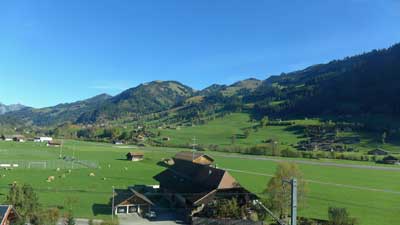
Geneva is a very famous city (though not for tourism reasons) on a lovely lake of the same name, but it’s also notoriously dull and lacking distinction. Rick Steves puts it well by saying that “Geneva is pleasantly situated on a lake, like Buffalo or Cleveland.” The point is, you don’t want to go to Geneva unless you’ve got something specific in mind that you want to see there. There are much better places to visit in Switzerland if your time is limited, or even if it’s not.
Switzerland's cities in summary
Zurich – The largest city, very expensive, geared towards business travelers. It’s generally a pretty and very well-run city that you would enjoy if you visited, but it’s not nearly as interesting as the likes of Vienna, Munich, or of course Paris.
Geneva – Second largest city, in the French part of the country, no major sights. Again, if you visited you’d be very impressed by it and get some great photos, but it’s not worth your time unless you know someone there. There’s an impressive fountain in the lake and you can usually see it from the train as you go through the city, but it’s not really worth going there and staying more than an hour or so.
Basel – Bordering France and Germany, no major sights. It has the famous art market each year, and aside from that it’s even duller than the ones above. Again, if you visited you’d be impressed, but if you later compared photos with friends who went to the Lauterbrunnen Valley instead, you’d kick yourself for going to Basel.
Lausanne – Near Geneva in the French part of the country, very hilly, and certainly more interesting than Geneva.
Bern – The capital, compact, on a lovely river, some interesting sights and the best Swiss city to get a feel for the culture. Bern is fairly close to Interlaken (which we will discuss below) and it can be a great day trip from there, especially on a day where it is foggy and/or rainy in the mountains (and this happens a LOT).
How much time and which Swiss cities to visit?
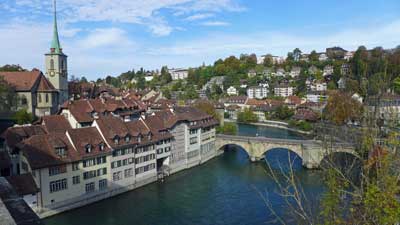
Many people (me included) don’t feel as if they’ve scratched the surface of a new country if they haven’t spent at least a day or two in the largest city. Zurich is certainly pleasant and a useful transit hub so spending one or two nights there wouldn’t be a major mistake. But Zurich isn’t even close to being a city like Paris, Rome, Berlin, Amsterdam, or even Vienna. If you skip it in favor of spending more time in the Swiss Alps, you won’t be missing much.
The 2 Best places to visit in Switzerland for short visits
Interlaken – If you want the best possible Alpine views and activities, head to the Interlaken area, which will be described in detail below. This is my favorite of all places to visit in Switzerland and it will probably be yours as well.
Lucerne – The traditional Swiss tourist retreat, Lucerne is a small city with interesting culture and sights, that is gorgeously set on a lake with plenty of top activities surrounding it.
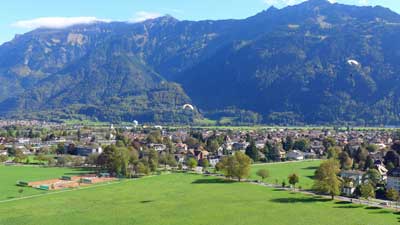
>>>Interlaken and Lucerne: Which to choose and how long to stay in each?
The article linked above will give you more details on which to choose and how long to spend in each place.
What about Zermatt for Alpine views?
Zermatt is a remote car-free village in southern Switzerland that is famous for being the place to see the Matterhorn mountain. It’s also a busy ski resort area, and aside from that, there isn’t much to see or do here. It’s on a private rail line, so it’s more complicated and usually more expensive to reach than Interlaken.
In other words, unless you’ve irrationally placed “Seeing the Matterhorn in person” on your so-called bucket list, skip Zermatt and head to Interlaken on a shorter visit. You won’t be sorry. If you already have enough time in your visit for the main sights around Interlaken and Lucerne and you want to also see the Matterhorn, then by all means go and you’ll enjoy it. There are quite a few other car-free villages in the Lauterbrunnen Valley near Interlaken, so they are not as novel in Switzerland as one might expect.
A weekend in Switzerland? What to see in 3 days
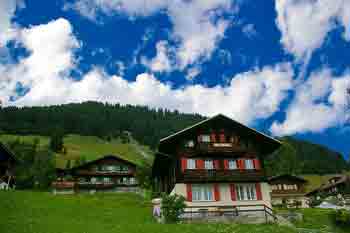
One challenge is that neither has an international airport so you’ll either be flying into Zurich or perhaps Geneva.
Train times from Zurich to Lucerne to Interlaken and back
- Zurich Airport to Lucerne: 1 hour 10 minutes by train
- Lucerne to Interlaken: 2 hours by train
- Interlaken to Zurich Airport: 2 hours 15 minutes by train
As you can see with the travel times above, Zurich Airport to Lucerne is a fairly short trip, but once you add Interlaken into the mix (even if you skip Lucerne) the travel time starts to add up for a weekend visit. With this in mind it’s probably best to just choose one of them and save the other one for another trip.
Lucerne is gorgeous, but the Lauterbrunnen Valley near Interlaken is really the star of the show, so I’d recommend going there first and doing Lucerne on another trip.
What about the Swiss Travel Pass?

The bottom line is that if you are coming to Switzerland for at least 3 days and you want to take 2 or more of the amazing scenic rail journeys that the country is famous for, the travel pass is probably a good deal. It also provides 50% discounts on the Schilthorn cable car and 25% off the Jungfraujoch mountain railway. Both of those are quite expensive on their own, but extremely worthwhile, so the discount is helpful.
The Half Fare Card is probably a better deal for most people
The Swiss Travel Pass is a good deal for those who are going to be spending at least 2 or 3 days riding the rails and seeing Switzerland that way. But if you are mostly going to be focusing on Interlaken and Lucerne and the mountain sights, the Half Fare Card is the best option. For CHF120 (about US$134) you get the card that is good for 30 days and gives you a 50% discount on all trains, cable cars, mountain railways, and other sights and attractions. If you are doing either Schilthorn or Jungfraujoch, the Half Fare Card practically pays for itself with just one of those.
>>>Buy the Swiss Half Fare Card
Many people have questions about the Swiss Half Fare Card so I will explain it a bit here. You can actually buy half price train tickets for travel within Switzerland any time you want and you will see that option when you go to buy them online. The only thing is you have to have and present a valid Half Fare Card when you get on the train and are asked to see your ticket. In other words, you can buy a half fare train ticket today and buy a Half Fare Card just before you get on that train months in the future, and you are fine.
How and why visit the area around Interlaken
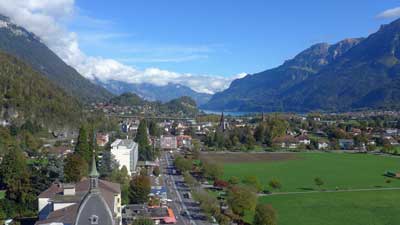
You can see everything discussed below by actually staying in a hotel in Interlaken, but it’s not the Alpine experience that you get if you stay in one of the small villages nearby. You can reach those villages in 20 to 40 minutes from the Interlaken Ost (East) train station, and it’s much easier than it sounds.
The 3 best places to stay to visit the Swiss Alps
Lauterbrunnen – A private train line runs from Interlaken Ost station to the end of its line in Lauterbrunnen. There’s a lovely waterfall here and great hiking trails, but you should probably only stay here if you can’t get to one of the villages mentioned just below. It’s a great little transit hub and it’s definitely gorgeous, so it can be worth a night if you’ve got one to spare.
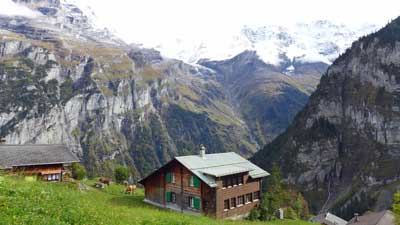
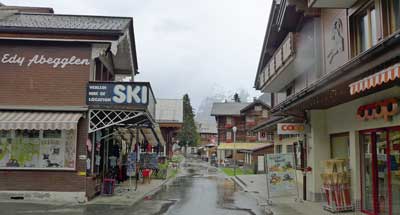
Where to stay in Interlaken and the Lauterbrunnen Valley (with pics)
I get so many questions about where to stay in the Interlaken area that I decided to write a longer version of it and load it with huge photos so readers can get a better feel for each option. I also included recommendations for affordable and well-located photos in each area.
>>>Where to stay in Interlaken and the Lauterbrunnen Valley New for 2024!
The unforgettable things to see here (if the weather is decent)
Schilthorn observation deck and restaurant
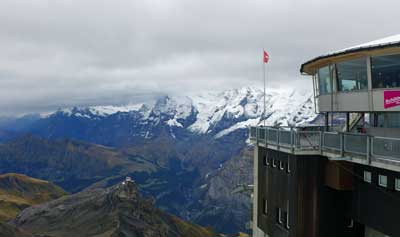
There is a rotating restaurant (with prices similar to normal Swiss restaurants) and a bizarre and anachronistic James Bond attraction based on it being a key location in the 1969 movie On Her Majesty’s Secret Service. The Bond thing is included with the lift, and it’s worth a look.
But the main thing you come here for is the 360-degree view from one of the highest peaks in Europe. Again, the weather here is key, but fortunately all the locals track the visibility on a minute-by-minute basis. If it’s clear up top while you are in the area, it would be a terrible shame to skip it based on the high price. But even if it’s cloudy up top, there are still plenty of wonderful things to see and do in the villages below.
Jungfraujoch observation area
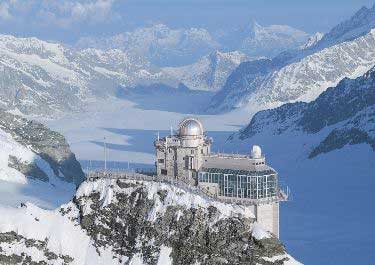
The views from the top are similar to the views from Schilthorn, from the other side of the Lauterbrunnen Valley. Once on top you can have lunch, hike, or even go sledding. It’s also quite expensive at nearly US$200 round-trip unless you have a Swiss Pass or a Eurail Pass for discounts, and it takes most of your day, but you’ll never forget the views from the top.
Harder Kulm mountain and Two Lakes Bridge Observation Deck
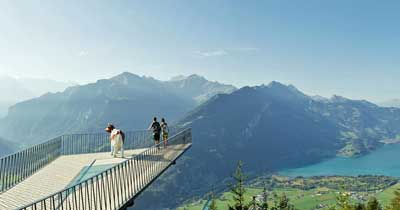
There’s a revolving restaurant about 10 minutes’ walk from the station at the top, which is definitely an unforgettable place for lunch if you’ve got time. It’s not as expensive as you might expect, at least compared to normal restaurants in Switzerland.
The Harder Kulm Railway goes from early April through late November each year. If you are only in Interlaken for one day and/or you are on a strict budget, this is the fastest and best way to get amazing Alpine views in the area.
Getting from Interlaken to Gimmelwald and Mürren
Getting up to these villages sounds complicated and time consuming, but it’s actually fast and easy once you get there. This little guide should help.
Arrive in Interlaken
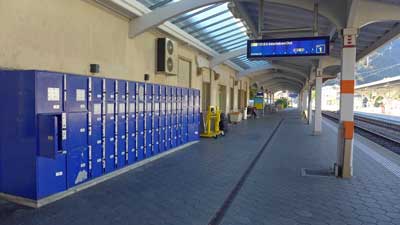
Once you arrive at the Interlaken Ost train station, head for the ticket windows in the office and buy a ticket to your final destination (Lauterbrunnen, Gimmelwald, or Mürren). Eurail passes are good for 25% discounts on the rest of the trip, but not for the whole thing.
From Interlaken Ost to Lauterbrunnen
The private train leaves Interlaken Ost every 30 minutes and arrives in Lauterbrunnen 20 minutes later. If you are staying in Lauterbrunnen then you are probably walking distance from your hotel when you reach the station.
From Lauterbrunnen to Gimmelwald
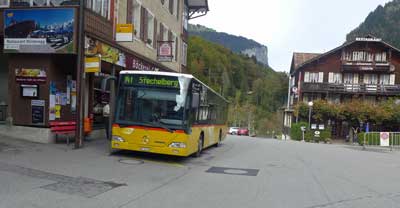

From
Gimmelwald to Mürren
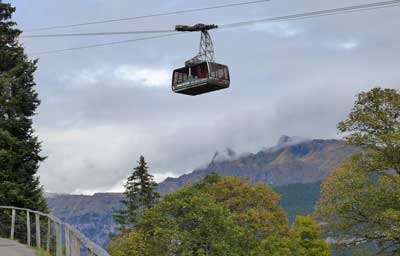
Recommended hotel and hostel in Gimmelwald
I get asked all the time about where to stay in Gimmelwald, so here it is:
Hotel: Esther’s Guesthouse
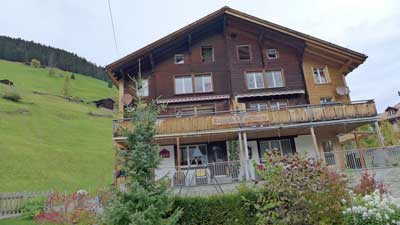
It’s run by Esther, as you might guess, and she is very friendly speaking excellent English. Each room is different and the place feels like a mountain cabin, because it is. She offers an excellent buffet breakfast in the morning, which you have to order the night before. It’s not cheap, but it’s worth it because it’s hearty and there are no other good options nearby.
Book as early as possible because this place is often the first place to sell out in Gimmelwald.
Hostel: Mountain Hostel Gimmelwald
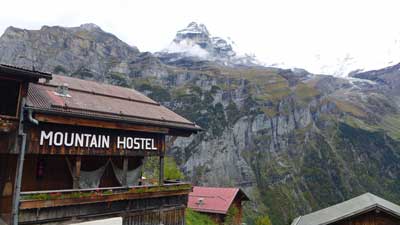
You won’t believe the views from this place, which are the same as from Esther’s except a bit lower and more unobstructed. This place also has a busy bar and restaurant that is basically the only “nightlife” in Gimmelwald. Many hikers get to bed early in this tiny village, but if you want to have a couple drinks and order a pizza or some local options, this is the place to go.
Again, book early because this place is always sold out.
Lucerne and what to do there
Luzern, as it’s spelled locally, is the other traditional holiday destination in Switzerland. Unlike Interlaken, Lucerne actually qualifies as a small city rather than a small resort town, so it’s a very nice contrast and very worthwhile. We have a new article with advice on where to stay in Lucerne and it should be helpful.
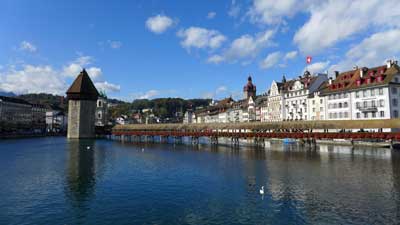
However, unlike Interlaken, the town of Lucerne itself is a great attraction and worth at least a day of exploration. This has always been a rich area so you can expect to find all of the high-end shops and boutiques along the small streets just north of the lake, but there are also many traditional shops and things to see that will appeal to anyone.
Recommended hotel in Lucerne
>>Hotel Des Alpes (3 stars with an amazing location and view)

If this place is booked, which is often the case, then book a hotel as close to it as you can find or afford. The whole historic part of town surrounding it is lovely, with restaurants, bars, and high-end shops. There are also a couple of nearby supermarkets where you can buy inexpensive alcohol and picnic supplies to keep other costs down.
Spend a day in Lucerne itself
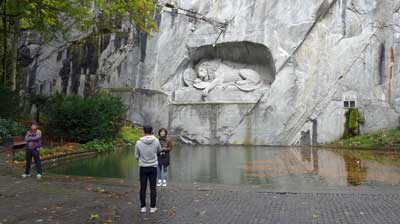
Most of the interesting part of Lucerne is in the area behind those restaurants, and it’s certainly worth doing a self-guided walking tour if not a guided one. Heading farther east you’ll come to another older part of town where the famous lion statue is located. You can’t visit Lucerne without having a look at the lion, and fortunately it’s easy and quick to reach (and it’s free).
Take a lake cruise of some kind
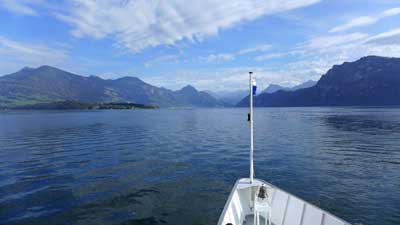
Especially in nice weather, even the short lake tour is lovely, and if you have more time you can jump off at Vitznau and do the scenic hike up Mount Rigi. There are also small lakeside villages that are ideal for a stroll and lunch stop. Long story short, there are dozens of interesting sightseeing options that are available using part of the boat tour, and the views all around are wonderful.
Visit Mount Pilatus
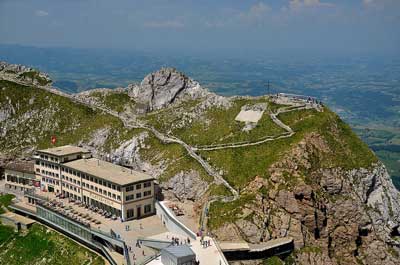
You can take the cogwheel train up and have a more or less flat hike around the summit area, and then take the gondola and cable car back down again. You can do them in the other order, and the cost is the same either way. At around US$65, this is not a cheap hike, but like most everything in Switzerland, the quality is high so it doesn’t feel like a rip-off. You can reach the cable car in 10 minutes on a public trolly bus from Lucerne.
Visit Mount Rigi
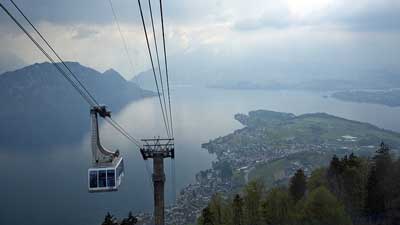
Unlike the other peaks mentioned in this article the Swiss Travel Pass covers both ways to get up and down for free. The others are 50% off with the Swiss Travel Pass or Half Fare Card, except for Jungfraujoch, which is only 25% off with the Swiss Travel Pass and still 50% off with the Half Fare Card.
Visit Mount Titlis
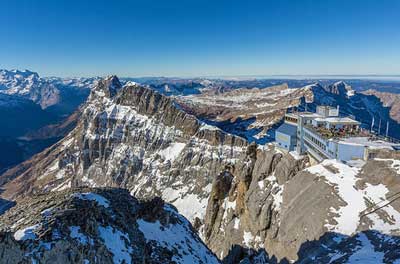
You can reach Titlis by taking a 43-minute train ride from Lucerne to Engelburg and then taking the cable car up from there. As with the others, it’s wise to check the weather immediately before you are going to depart because it can be foggy or cloudy any time of the year, but usually not for whole days at a time.
Additional photo credits
Jungfraujoch by cupweuro on Flickr, Pilatus by Tony Fernandez on Flickr, Rigi by Kosala Bandara on Flickr, Titlis by PaulSchliebs on Flickr

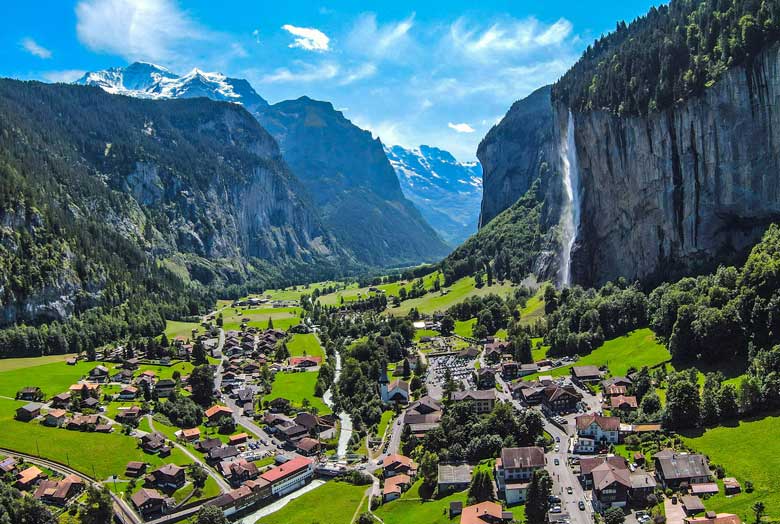
hi, i am anand mehta age 47, coming first time to Switzerland in mid November 2018, please guide me, where to start and what to see in 5 nights..
Anand,
The article above is actually meant to help people figure out where to go on a short trip like that. The short version is you should probably spend 3 nights in the Interlaken area and 2 nights in the Lucerne area. All of the top sights are mentioned in the article, along with the best areas for hotels. One challenge you’ll have is that some hotels and restaurants close down from mid October until mid December because that’s the slow season after the summer hikers and before the skiers arrive. Some places are open all year so you’ll be able to find restaurants and hotels, but there are fewer available because it’s the slow season. Let me know if you have any specific questions. -Roger
Hi @ Roger (sorry for referring as David 🙂 ). Your post is the best post after searching so many through google and tripadvisor.
I want to travel to Switzerland in this Oct and I wil be travelling from Paris. Which airport I chose to arrive to save time and local sightseeing in switzerland? I want to live only two nights or more preferably one night and cover either Interlaken Or Lucenrn or both of them if time permits. Can I also take one of the cable cars to go to some peak and come back? And as you mentioned the normal train between local trip will be as good as scenic trains, I am ok to skip the scenic trains. I will still be buying the swiss travel pass to keep the flexibility and hop on whatever little journeys I can take. What dp you recommend for one night/two days trip? one two nights/two day trip with early afternoon departure on third day. Thanks in advance.
Praveen,
Thank you for the nice words. If you have only one or two days I would highly recommend focusing on the Interlaken area only. Lucerne is very nice, but the peaks above Interlaken are higher and more dramatic and more interesting. I think buying a Swiss Travel Pass is a great idea and if you do I would put the cable car up to Schilthorn on top of your list because it’s fully covered by the pass. You won’t have time for any of the scenic trains, but as I’ve mentioned before, ALL of the train rides in those areas are very scenic if you are just going from place to place. If you have time to go to Lucerne even for half a day it could be worthwhile since it will be free with the Swiss Travel Pass. The journey is actually part of the Goldenpass scenic line, and the town of Lucerne is really lovely. The town of Interlaken has a gorgeous location, but the town itself isn’t as photogenic as Lucerne so you might want to stay in Lauterbrunnen or Gimmelwald or Murren for a more interesting experience. Let me know if you have any other questions. -Roger
Dear Roger
thanks for reply, its been helpful.
couple of things more to ask.
i have already sorted out things to do at Luzerne and Murren.
My question is what activities to do in interlaken other than strolling around? we would have one full day there.
other thing to ask is would we be better off by buying half fare card considering young family and our trip to swiss is concentrated to these places only with limited tours/trips.
thanks
Hi Roger,
Thank you so much for your response. It made me feel better and now I am excited again for the trip. Hope it turns out great. Kudos to you for efforts in answering everybody with detailed help and suggestion. May God bless you.
HI Roger
i Have read many of your posts and replies and you doing really good job.
coming to my query, i am travelling to swiss next week for 3.5 days before moving on to other part of europe. i am travelling with young family(young kids of age 6 and 2). i have planned to spend one day each at Luzerne,Murren and interlaken itself.
can you recommend me what activities to choose considering time constraint and mobility as far young family is concerned.
i have fair idea of popular things to do but seek your opinion by keeping time factor in view .
Thanks
Choudary,
I’m glad you find this site and my advice useful. Really, my best suggestions for each place are all in the article above. In Lucerne you’ll want to do the boat trip and explore the city itself. Murren is on the same mountain that Schilthorn is at the top of, and I think the kids would be free so that could be a great option. Going up by cable car should be fun and there isn’t much walking to do at the top.
The mobility issue is something to consider, but really I think you’ll be fine. The Swiss buses and trains are the nicest in Europe and you should have room for a stroller if needed. You wouldn’t want to do any of the longer or more challenging hikes, of course, but in your short visit I think you’ll have plenty of options that require very little walking, such as Schilthorn. There is an impressive waterfall in Lauterbrunnen on the way from the train station to the Stechelburg cable car stop up to Murren, so you can visit that. I think the trip will work out well and you won’t be short of options of things to do. -Roger
Hi Roger,
Your blog has been extremely useful in planning my Swiss trip which is coming next week 17th -22Aug. Recently I saw that the weather will be bad on those days at most of the locations. I cannot cancel the trip as it would cost me more. What do we do when weather goes bad. My itinerary is:
Aug 17th: Zurich to St Moritz
18th: Glacier express, st moritz to Zermatt
19th: Zarmatt site seeing and to interlaken by evening
20th: Schlithron first half, to lucern by evening
21st: Mt Rigi and Pillatus
22ns Lucern to Zurich
Does it makes sense to be onboard Glacier express on a rainy day?
What do you suggest to salvage the trip. I am open to change mu itinerary.
Thanks a lot.
Yagal,
I’m happy that this site has helped so far. First of all, the weather probably won’t be as bad as the forecast suggests. It’s true that the summer months are the “rainy season” in the Alps, but it’s rare that it just rains and rains and rains. If you see the forecast for, say, one week from today and it predicts rain, that means that it will probably rain for at least part of that day, although it may not. You might get very unlucky and it rains most of the day for a few days of your trip, but most likely it’ll rain for a few hours in the morning and then clear up, or be clear in the morning and then be rainy in the afternoon.
So you can probably do most or all of your itinerary as it’s planned and you’ll be fine. The one thing you really want to avoid is going up to the top of one of the mountains (such as Schilthorn) when it’s very cloudy or foggy at the top. The worst times are when the mountain tops are basically within the clouds, and visibility is pretty much zero so there is no point in going. That can happen any day of the year, including in summer, so the locals monitor the conditions constantly. There are webcams at the top of each mountain that show the current view and the prediction. When it’s foggy on top no one goes up, so it’s best to go as early as you can when it’s nice up there, or wait for it to clear up again.
When it DOES rain in summer it’s often just a light rain and you can carry on with a hike or train ride or whatever else. Even when it’s cloudy out Switzerland still looks beautiful on the valley floors and those train rides are enjoyable. The city of Lucerne is really gorgeous as well, so spending half a day wandering around and checking out the Chapel Bridge and the lion statue is fun, and the boat cruises are pretty good in all kinds of weather as well. If you get unlucky and it’s raining steadily you still might go to Bern, which is the capital and the most photogenic city. It’s only about an hour from Interlaken by train and often the weather there is different from the mountains.
So fingers crossed that the weather isn’t as bad as the forecast indicates, and I still think you’ll be able to do most of the things on your list. -Roger
Hi Roger,
I have booked 5 nights in a hotel in Interlaken. Its close to the Interlaken West station. I will be arriving on 14th Afternoon sometime.
So i will have sometime on 14th and then full days 15,16,17,18. In these 4 days I would like to visit atleast top 5 or 6 locations nearby. Could you recommend what could be those 5 or 6 locations i must visit during this short span of time. I am planning to buy the Swiss Travel Pass.
Thank you so much. Your answers are always in very detail.
An addition to above. I think I am late in buying the Swiss Travel Pass. It gives me starting date 16th. Can I get a pass from Bern Airport or any Station there which can be activated immediately?
Safwan,
I’ve listed the most popular attractions in the main areas in the article above, and beyond that I really don’t like to get into planning people’s holidays for them. You can find countless lists of things to do in Interlaken on the internet and you might also consider a guidebook or an electronic guidebook. There are just too many things to choose from and the ones that I consider interesting might not be so interesting to you, aside from the most famous attractions like Schilthorn and Jungfraujoch.
And yes, you should be able to buy a Swiss Travel Pass at the first train station you visit, as long as it’s one of the major stations that has a ticket office rather than just a ticket window. Have a great trip. -Roger
Thanks Roger. Could you also advise regarding train transport. I am planning to come from Vienna by train. Which train service I should look for. And if there is any travel pass i should have which would give me discounts?
Safwan,
All of the normal trains in Switzerland are run by their national rail company called SBB. You can book through their official website, which is sbb.ch.
I discuss the Swiss Travel Pass in depth in this link. Most likely you’ll be best off with the Half Fare Card, which is also discussed in that article. It will even cover your train fare at half price from when you reach the Swiss border on your way in and out. Let me know if you have any other questions. -Roger
Hi Roger,
Excellent article. Thanks for this effort.
I will be travelling to Zurich on 14th Aug. From there same day i am planning to travel to Interlaken most probably. My stay would be till around 20th Aug.
-First i would like to ask that out of Interlaken, Thun & Spiez which one i should stay?
-And would that be fine to stay in one of these places for the complete duration and just do the day trips to nearby locations?
-Any hotels that you can recommend in these areas? I would really prefer something just next to the lake.
Thank you in advance.
Safwan,
If you are looking for a place to stay as a base to reach the best sights, views, and attractions in that area I would stay in Interlaken. There are more hotels and restaurants and such near the Interlaken West train station, but the Interlaken Ost (east) train station is the real transit hub for everything in the area. All trains stop at both stations and if you are staying in Interlaken your hotel or hostel will give you a card for free transportation on buses and even the trains between the stations. And just between you and me, I’m pretty sure they never check tickets in the 5 minutes between those two stations, so you can ride for free anyway.
You might also want to stay in Gimmelwald, Murren, or Lauterbrunnen, as mentioned in the article above. Those are deep in the valley with Lauterbrunnen on the valley floor and Gimmelwald on the side of the mountain above that, and Murren just above Gimmelwald. If you can stay in Gimmelwald for 1 or 2 nights you’ll never forget it. You might also consider visiting the Lucerne area for a day or two, so staying there at least one night could be worthwhile.
I can recommend the hotels and hostels I mention in the article. Generally speaking, hotels in these areas are very expensive but also of high standards. You can trust reviews on TripAdvisor and booking.com for the most part. Let me know if you have any other questions. -Roger
I am interested in going to Grimmelwald and surrounding area to hike and enjoy the scenery/mountains. Time of year is totally flexible, temperature is not an issue but prefer to avoid rain and snow as much as possible. Are there any times of the year where there is a higher probability of good weather without needing crampons?
Thanks,
Barbara
Barbara,
It’s easy to confuse Gimmelwald and Grindelwald since they are so close together. Gimmelwald is the tiny farming village mentioned in the article above, and Grindelwald is a larger resort town on the other side of the Lauterbrunnen Valley that is also gorgeous, although much larger. There is some “technical” mountain climbing available in the Interlaken area with crampons and equipment and all that, but 99% of visitors are just there to hike on the many trails all over the area.
The most reliable time of year is probably the late spring. The summer months in the Alps are also the wettest months, although it rarely rains for full days or multiple full days. And of course the summer months have the nicest temperatures. From mid October until mid December many of the smaller hotels and restaurants in the area are closed, although many others are open. Those two months are the slowest season for outdoors and then starting in mid December there is usually enough snow for the lifts to open, so there is snow tourism through March or sometimes April. The higher you are on the mountain the more chance of snow at any given time, and there is year-round snow at the very tops of the mountains.
So you’ll never need crampons for normal hikes and many of the most scenic trails are paved and usually free of snow even in winter. I’d go in May or early June for the best chance of clear and dry weather. -Roger